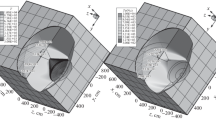Abstract
Consideration has been given to a number of aspects of mathematical modeling of a high-velocity flight in the earth’s atmosphere in a wide range of variation of the determining parameters. Super-and hypersonic gas flow past flying vehicles has been investigated based on computer-aided calculations with allowance for its actual properties. Data on the distribution of gasdynamic parameters in the flow field, including thermal and force loads on the surface, have been obtained and analyzed. The issues of applying today’s information technologies to archiving scientific knowledge obtained in electronic databases of a specialized Internet center and their dissemination via the Global Network have been discussed.
Similar content being viewed by others
References
J. F. Clarke and M. McChesney, The Dynamics of Real Gases [Russian translation], Mir, Moscow (1967).
a. B. Zel’dovich and Yu. P. Raizer, Physics of Shock Waves and of High-Temperature Hydrodynamic Phenomena [in Russian], Nauka, Moscow (1966).
V. M. Kovenya, G. A. Tarnavskii, and S. G. Chernyi, Use of the Method of Splitting in Aerodynamics Problems [in Russian], Nauka, Novosibirsk (1990).
G. A. Tarnavskii and S. I. Shpak, Decomposition of methods and paralleling of the algorithms of solving aerodynamics and physical gas dynamics problems, Programmirovanie, No. 6, 45–57 (2000).
G. A. Tarnavskii and V. D. Korneev, Paralleling of the program complex of mathematical simulation of real-gas high-velocity flows, Avtometriya, 39, No. 3, 72–83 (2003).
W. G. Hayes and R. F. Probstein, Hypersonic Flow Theory [Russian translation], IL, Moscow (1962).
R. Feynman, R. B. Leighton, and M. Sands, Feynman Lectures in Physics, Vols. 3–4: Radiation, Waves, Quanta, Kinetics, Heat, Sound [Russian translation], Mir, Moscow (1976).
I. Prigogine and D. Kondepudi, Modern Thermodynamics. From Heat Engines to Dissipative Structures [Russian translation], Mir, Moscow (2002).
G. A. Tarnavskii and S. I. Shpak, Efficient adiabatic exponent in the problems of hypersonic flow of real gas around bodies, Teplofiz. Aéromekh., 8, No. 1, 41–58 (2001).
G. A. Tarnavskii, Shock waves in gases with different adiabatic exponents before and after the shock, Vychisl. Metody Programmir., 3, No. 2, 129–143 (2002).
G. A. Tarnavskii, Shock-wave structures in real gases: transition between different types of interaction of shocks in the region of the solution nonuniqueness, Vychisl. Metody Programmir., 5, No. 2, 219–228 (2004).
G. A. Tarnavskii, Influence of flow angularities in a hypersonic ramjet diffuser on the formation of the shock-wave structure of the real gas flow, Inzh.-Fiz. Zh., 77, No. 3, 155–164 (2004).
G. A. Tarnavskii, Shock-wave regimes of flow at the inlet to the diffuser of a hypersonic straight-flow air-jet engine: influence of the altitude and speed of flight, Teplofiz. Vys. Temp., 43, No. 1, 57–70 (2005).
G. A. Tarnavskii, Shock-wave flow regimes at entry into the diffuser of a hypersonic ramjet engine: influence of physical properties of the gas medium, Inzh.-Fiz. Zh., 79, No. 4, 69–80 (2006).
G. A. Tarnavskii and S. I. Shpak, Techniques of calculation of the effective adiabatic exponent in computer modeling of hypersonic flows, Sib. Zh. Industr. Mat., 4, No. 1(17), 177–197 (2001).
N. B. Vargaftik, Handbook on the Thermophysical Properties of Gases and Liquids [in Russian], Fizmatgiz, Moscow (1963).
A. N. Migun, E. A. Matveichik, A. P. Chernukho, and S. A. Zhdanok, Object-oriented approach to simulation of chemical reaction kinetics, Inzh.-Fiz. Zh., 78, No. 1, 153–158 (2005).
G. A. Tarnavskii and S. I. Shpak, Problems of numerical simulation of a supersonic laminar-turbulent flow around finite-size bodies, Mat. Modelir., 10, No. 6, 53–74 (1998).
G. A. Tarnavskii and S. I. Shpak, Calculation of heat fluxes in supersonic viscous gas flow around bluff bodies, Izv. Ross. Akad. Nauk, Mekh. Zhidk. Gaza, No. 3, 179–183 (1999).
V. F. Volkov and G. A. Tarnavskii, Disturbance of symmetry and hysteresis of stationary and quasi-stationary solutions of the Euler and Navier-Stokes equations, Zh. Vych. Mat. Mat. Fiz., 41, No. 11, 1742–1750 (2001).
G. A. Tarnavskii and S. I. Shpak, Certain aspects of computer simulation of hypersonic flows: stability, nonuniqueness, and bifurcation of numerical solutions of the Navier-Stokes equations, Inzh.-Fiz. Zh., 74, No. 3, 125–132 (2001).
G. A. Tarnavskii, G. S. Khakimzyanov, and A. G. Tarnavskii, Modeling of hypersonic flows: influence of the starting conditions of the algorithm on the final solution in the vicinity of bifurcation points, Inzh.-Fiz. Zh., 76, No. 5, 54–60 (2003).
S. N. Korobeinikov, Nonlinear Deformation of Solid Bodies [in Russian], Izd. SO RAN, Novosibirsk (2000).
G. A. Tarnavskii, A. G. Tarnavskii, and K. V. Gilev, Informational-computational Internet-Center “Aeromechanics.” The firstline: program complex “Shock,” Vychisl. Metody Programmir., 6, No. 1, 27–48 (2005).
G. A. Tarnavskii, A. G. Tarnavskii, A. V. Aliev, and S. B. Zhibinov, Informational-computational complex “Flow” of the Internet-Center for dissimination of scientific knowledge, Infosfera, No. 34, 35–38 (2007).
G. A. Tarnavskii, A. V. Aliev, and A. G. Tarnavskii, Computer simulation in aeromechanics: program complex “Flow-5,” Aviakosm. Tekh. Tekhnol., No. 4, 27–38 (2007).
Author information
Authors and Affiliations
Corresponding author
Additional information
__________
Translated from Inzhenerno-Fizicheskii Zhurnal, Vol. 81, No. 2, pp. 338–344, March–April, 2008.
Rights and permissions
About this article
Cite this article
Tarnavskii, G.A. Thermal and force loads on the vehicle surface in high-velocity motion in the earth’s atmosphere. J Eng Phys Thermophy 81, 359–365 (2008). https://doi.org/10.1007/s10891-008-0043-2
Received:
Published:
Issue Date:
DOI: https://doi.org/10.1007/s10891-008-0043-2




